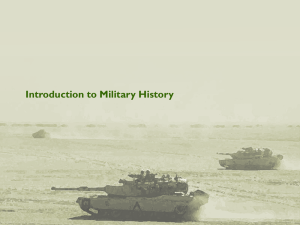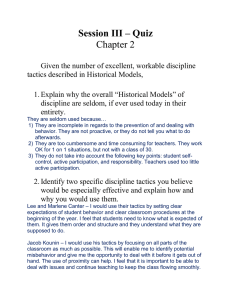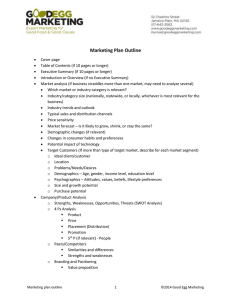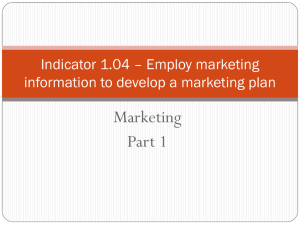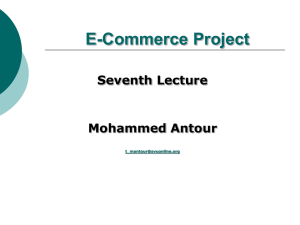Communicating Upward Influence Attempts in Organizations Mahfooz A. Ansari
advertisement
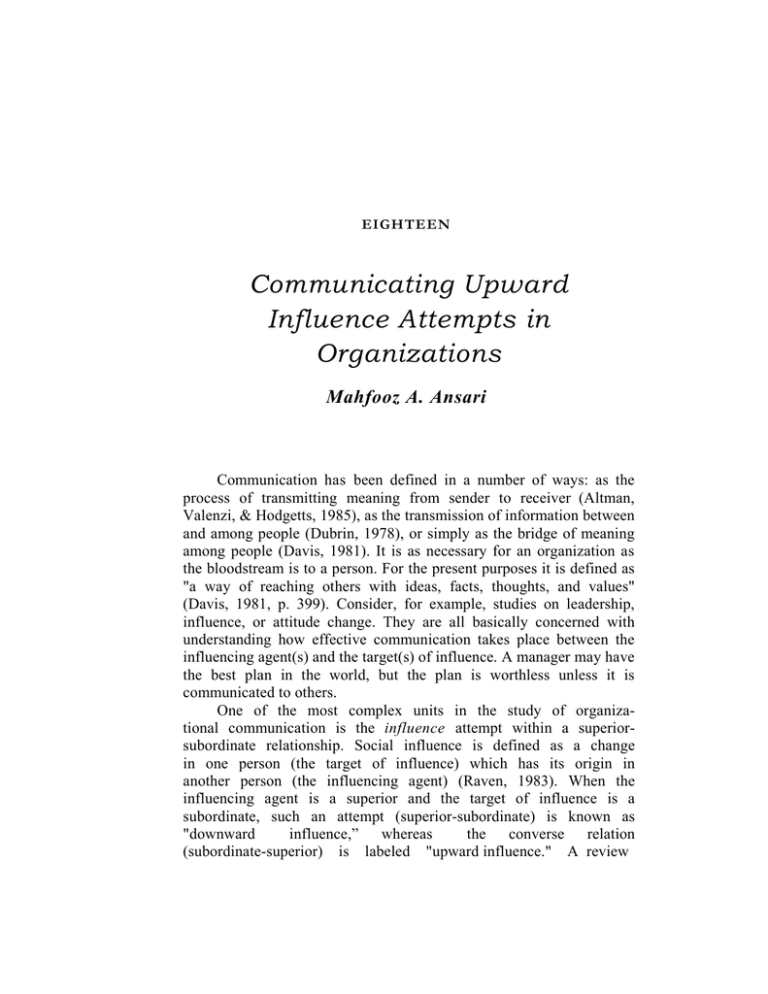
EIGHTEEN Communicating Upward Influence Attempts in Organizations Mahfooz A. Ansari Communication has been defined in a number of ways: as the process of transmitting meaning from sender to receiver (Altman, Valenzi, & Hodgetts, 1985), as the transmission of information between and among people (Dubrin, 1978), or simply as the bridge of meaning among people (Davis, 1981). It is as necessary for an organization as the bloodstream is to a person. For the present purposes it is defined as "a way of reaching others with ideas, facts, thoughts, and values" (Davis, 1981, p. 399). Consider, for example, studies on leadership, influence, or attitude change. They are all basically concerned with understanding how effective communication takes place between the influencing agent(s) and the target(s) of influence. A manager may have the best plan in the world, but the plan is worthless unless it is communicated to others. One of the most complex units in the study of organizational communication is the influence attempt within a superiorsubordinate relationship. Social influence is defined as a change in one person (the target of influence) which has its origin in another person (the influencing agent) (Raven, 1983). When the influencing agent is a superior and the target of influence is a subordinate, such an attempt (superior-subordinate) is known as "downward influence,” whereas the converse relation (subordinate-superior) is labeled "upward influence." A review 194 ASPECTS OF HUMAN COMMUNICATION of literature (Ansari & Kapoor, 1 9 8 7 ; Kipnis, Schmidt, & Wilkinson, 1980; Mowday, 1 9 7 8 ; Offermann & Schrier; 1 9 8 5 ; Porter, Allen, & Angle, 1 9 8 1 ; Schilit & Locke, 1982) indicates that communicating influence attempts in general have received attention mostly under such general frameworks as leadership and group dynamics. The prime concern in such investigations has been downward or lateral influence process. Unfortunately, upward communication (influence) has been given minimal consideration in organizational research. Thus, the present paper addresses itself to the communication strategies that subordinates use in their attempts to influence the superiors. The discussion is divided into three sections: First, a brief orientation to the key elements relating to upward influence is presented. The second part provides a review of the relevant literature. And f i n a l l y , a general framework for studying communication strategies in an upward influence attempt is specified. KEY CONSIDERATIONS Importance of Upward Influence For the proper and effective functioning of an organization, a sound, harmonious relationship between superiors and subordinates is needed. Many years ago, Likert (1967) emphasized the importance of the "linking pin" function, which was geared toward the facilitation of "vertical communication." The focus was on free communication between the leader and subordinates. It follows that the power to attain personal, group, or organizational goals should not be restricted to downward influence in organizations (Gamson, 1968). In essence organizations are continuously at the mercy of their lower participants (Mechanic, 1962). Since the influence ability of subordinates over superiors may be an essential ingredient of organizational effectiveness (Gabarro, 1979; Kanter, 1977; Pelz, 1952; Weinstein, 1979), it has been considered to be one of the relevant topical areas of organizational communication research (Jablin, 1985). This point deserves detailed discussion. "Upward influence" has been defined as "influence attempts directed toward someone higher in the formal hierarchy" COMMUNICATING UPWARD INFLUENCE ATTEMPTS 195 (Porter et al., 1981, p. 111). It should be emphasized that subordinates may have considerable power but no authority. Such personal power does not only result from the unique characteristics of the influencing agents, but also from the particular aspects of their location within their organizations (Mechanic, I962). The secretary of a managing director, for example, may not have any authority (position power) but may have considerable information power and thus have impact on many of the top managers in his or her organization. This feature alone makes the topic of upward influence especially interesting to sociologists and social psychologists. Influence Tactics Social psychologists have identified many methods of influencing behaviors such as physical and environmental control, behavior modification, or body language. Of these methods, "the most frequently studied are the words that people use to persuade others" (Kipnis, 1984, p. 181, emphasis added). It is estimated that organizational members spend nearly 70 per cent of their working hours communicating: writing, reading, speaking, and listening (Robbins, 1983). The content (message) of the influence attempt has been mentioned most commonly as the cause of success by both subordinates and superiors (Schilit & Locke, 1982). Two forms of communication are common to an influence attempt: nonverbal (kinesis, proxemics, and paralanguage) and verbal (written and oral). The remainder of this paper focuses on verbal influence attempts directed toward someone higher in formal hierarchy (hereinafter called upward influence). Some of the most commonly used methods of upward influence are presented (in alphabetical order) below. Assertiveness. Also known as persistence, this strategy includes direct and forceful words. Kipnis (1984) has considered it a strong strategy. Example: "I demanded that he or she do what I requested." Defiance. This strategy draws upon coercive power and involves such words as challenging the ability, voicing the wishes loudly, or opposing (Ansari, 1987; Singh, 1985), Example: "I voiced my wishes loudly." 196 ASPECTS OF HUMAN COMMUNICATION Diplomacy. This strategy involves a show of respect, concern, or support (Ansari, 1987; Singh, 1985). Example: "I made a show that I had respect for him or her." Exchange. Also known as bargaining, this strategy draws upon reward power. It involves the exchange of benefits or favor (Kipnis et al., 1980). Example: "I offered to help if he or she did what I wanted." Expertise. This strategy draws upon expert power (French & Raven, 1959). It involves the use of superior knowledge, competence, or experience (Ansari, 1987; Singh, 1985). Example: "I showed my knowledge of the specific issue.” Ingratiation. Also known as informal or nonperformance-specific exchange (Schilit & Locke, 1982). This strategy involves the use of interpersonal attraction, impression management, flattery, and the creation of goodwill (Kipnis & Vanderveer, 1971; Kipnis et al., 1980; Mechanic, 1962). This is considered to be a weak strategy (Kipnis, 1984), Example: "I used words which made him or her feel good." Manipulation. This strategy involves the use of information or arguments presented in such a way that the target is not aware of being influenced (Mowday, 1978; Porter et al., 1981). Example: “I distorted orlied upon the information required for an important issue.” Pseudo-dependency. This strategy involves making an impression that the agent cannot really work without the help of the target, or pretending that the target has the responsibilities to decide things for the agent (Ansari, 1987; Singh, 1985). Example: "I pretended as if he or she had the responsibilities to decide things for me." Reason. This strategy is also known as rational persuasion (Ansari & Kapoor, 1987; Yukl, 1981), rationality (Cheng, 1983; Kapoor, 1986), or persuasive arguments (Mowday, 1978). This is considered to be a rational one and involves the use of facts and data to support the development of logical arguments (Kipnis, 1984; Kipnis et al., 1980). Example: "I told him or her the reasons for my request." FOCI OF RESEARCH: A REVIEW People demand compliance in one instance, plead in COMMUNICATING UPWARD INFLUENCE ATTEMPTS 197 another, and give reasons in a third (Kipnis, 1984). Unfortunately, there is not much of substantial research relating to the issue of why subordinates differ in the choice of communication strategies when influencing their superiors. The few research findings reported are inconclusive. Some suggest that subordinates most commonly use covert message tactics (Porter et al., 1981), whereas others suggest that they most frequently employ rational/logical presentation of ideas (Ansari, 1987; Ansari & Kapoor, 1987; Cheng, 1983; Kapoor, 1986; Kipnis, 1984; Schilit & Locke, 1982). Thus Jablin (1985, p. 628) comments: "a subordinate's selection and use of a message strategy in an (upward) influence attempt . . . (appears) dependent on a wide array of situational factors." The fundamental aim of this section is not to present a comprehensive review of the literature. Rather, the attention is directed at providing a brief orientation to representative research in this area. Much of the published literature on the subject of upward influence seems to capture four different categories: (a) agent, (b) target, (c) climate, and (d) objectives of influence attempt. A review of research themes and specific issues will set the stage for the outline of a general framework which is provided in the next section. Agent Each organizational member brings to the scene a set of unique personal characteristics. Such characteristics also have am impact on power relationships and they "could easily lead to two different organizational members either to perceive an identical situation differently or, even if they share identical perceptions, to behave characteristically in different ways" (Porter et al., 1981, p. 120). Among the personal characteristics that seem to affect the choice of influence tactics are the personal orientations of the agent in terms of such variables as needs for achievement and power (Kapoor, 1986; Mowday, 1979), Machiavellianism (Pandey & Rastogi, 1979; Ralston, 1985), locus of control (Kapoor, 1986; Porter et al., 1981; Ralston, 1985), and leadership style (Ansari, 1987). The current focus, particularly in the organizational setting, seems to have settled on three needs--achievement, power, and 198 ASPECTS OF HUMAN COMMUNICATION affiliation—of which the first two have been found to be related to various factors of organizational effectiveness (McClelland, 1965; McClelland & Burnham, 1970). Such relationships are also apparent in upward communication. For example, Singh (1985) studied the relationship between need for power and power strategies and found that domineering need for power contributed positively to three power strategies: personalized help to, pseudo-dependence on, and manipulation of one's immediate senior. Both Kapoor (1986) and Mowday (1979) reported that needs for power and achievement were significantly and positively related to persuasive arguments or reasoning tactics. In addition, while the two needs were positively related to manipulation strategy (Mowday, 1979), the achievement need positively contributed to such upward influence tactics as personalized help and ingratiation (Kapoor, 1986). Machiavellianism (Christie & Geis, 1970) is another personal orientation which can affect the agent's communication strategies in an upward influence attempt. A high Machiavellian, characterized as a manipulator of other people, can be "an extremely successful agent of social influence even in the absence of any obvious source of social power" (Shaver, 1977, p. 479). Falbo (1977), for example, found that people who were high in Machiavellianism reported tactics that directly involved manipulations such as deceit. This finding is quite consistent with that of a later study by Pandey and Rastogi (1979) who reported that high Machiavellians tended to use ingratiatory tactics significantly more often than did the low Machiavellians. Rotter (1966) maintains that individuals differ systematically in their beliefs regarding their success/failure. "Internals" tend to believe that their outcomes are the result of ability or the effort, whereas "externals" tend to believe that their outcomes are largely a function of' task difficulty or luck. Given the importance of locus of control, Ralston (1985) hypothesized that internals will use ingratiatory tactics more often than externals. Similarly, Porter et al. (1981) proposed that internals would favor political activism. In a recent field survey, Kapoor (1986) found that internal locus of control contributed a significant amount of variance in reasoning strategy—a finding opposite to the above hypothesis. Kapoor, Ansari, and Shukla (1986) then hypothesized that COMMUNICATING UPWARD INFLUENCE ATTEMPTS 199 locus of control as a personal variable may not affect independently the choice of tactics. But it may also depend upon what kind of person the target of influence is. Their experimental data supported this contention. It was found that those who were high on internal locus of control tended to choose more often rational persuasion strategy to influence their nurturant-task oriented or participative boss than to influence the autocratic boss. But both the high and the low internals were least likely to employ this strategy to influence their autocratic boss. Additionally, they found that both the high and the low internals had a greater tendency to employ upward appeal and blocking as power tactics in order to influence their autocratic boss, whereas high internals were least likely to employ these tactics with their nurturanttask oriented or participative boss. There is sufficient evidence in the literature to show that how a manager gets his or her way depends largely upon what kind of leadership style he or she possess. Unfortunately, relatively little research has been done on the impact of leadership styles on upward influence tactics. In one field survey (Ansari, 1987), managers were found to vary their upward influence tactics in relation to their own leadership styles. For example, participative managers were very often found to employ such tactics as ingratiation, exchange, diplomacy, and personalized help; task-oriented managers relied very often on expertise and reasons tactics; and bureaucratic and autocratic managers employed very often ingratiation and exchange as upward influence tactics. Target In a subordinate-superior (agent-target) relationship, it is not only the personal characteristics of the agent but of the target as well which would affect meaningfully and in organizationally important ways the choice of messages in an upward influence attempt. In view of this, Ansari and Kapoor (1987) conducted a role-playing simulation study to investigate the role of superiors' leadership styles on the subordinates' use of upward influence tactics. They found that subjects showed a greater likelihood of using such tactics as blocking, upward appeal, and ingratiation to influence the autocratic boss, whereas they 200 ASPECTS OF HUMAN COMMUNICATION showed a greater tendency to use rational persuasion to influence the nurturant-task oriented or participative boss. Similar findings were obtained in field settings by Ansari (1987) and Kumar (1986). Climate Past research (e. g., Baumgartel, 1981; Litwin & Stringer, 1968) has shown that organizational climates set by the top leadership can and do influence the motivational orientations of managers in specific and organizationally important ways. Perceptions of such elements as managerial competence, fairness in reward and rule-enforcement, and the like may define the prevalence of behavior in organizations. "New employees often learn about the behavioral norms by observing their superiors' behavior and interaction with the subordinates." During this observational process, "they construct a reality about the organizational environments and adapt their behavior accordingly" (Cheng, 1983, p. 339). Following this perspective, then, some experimental studies (Ansari & Rehana, 1986; Cheng, 1983) were conducted to examine the effect of climate on the use of upward influence tactics. Taken as a whole, they arrived at the conclusion that rational climate encourages the use of rational tactics (such as rationality) and political climate encourages the use of political tactics (such as ingratiation, threat, blocking, and upward appeal). Subsequent field studies (Ansari, 1987; Kapoor, 1986) also support the assertion that upward influence is a function of the climate of the organization, of which the individual is a part. Objectives of Influence The goals or objectives of influence attempt are yet another contextual variable affecting the choice of influence tactics. Broadly speaking, goals may be of two types: personal and organizational. Personal goals may include securing benefits or better work assignments. On the other hand, organizational goals may include encouraging others to perform effectively or to promote new ideas (Schmidt & Kipnis, 1984). Managers attempt to influence their superiors in order to achieve a variety COMMUNICATING UPWARD INFLUENCE ATTEMPTS 201 of individual and organizational goals. Both the work of Kipnis and his colleagues (Schmidt & Kipnis, 1984; Kipnis et al., 1980) and of Kapoor (1986) clearly points to the fact that managers vary their influence strategies in relation to their objectives of the influence attempt. Among other findings, they reported that subordinates often use ingratiation (i.e., the use of soft words) in order to seek personal benefits, whereas they use reasons (i.e., the logical presentation of ideas) when attempting to persuade their superiors to accept new ideas. Similarly, Ansari and his colleagues (Ansari & Kapoor, 1987; Ansari & Rehana, 1986) experimentally demonstrated that subordinates seeking personal benefits (e.g., promotion) from their superior had a greater tendency to employ such tactics as ingratiation and expertise. When attempting to pursue organizational goals (e.g., seeking additional personnel to meet company objectives), they had a tendency to choose such tactics as reason, upward appeal, and blocking. Thus, the more different goals a subordinate has for influencing the boss, the greater the range of tactics that are used (Kipnis, 1984). LOOKING INTO FUTURE An overall observation of the above body of research suggests that very few studies have analyzed the role of message tactics used to effect upward influence in organizational settings. On the basis of the foregoing discussion, a general framework is suggested for future research (see Figure 1). The framework draws heavily on the recent work by Raven (1987) and Schein (1977). The explanation considered viable in the present model is that integration results from a combination of variables. As has been mentioned earlier that individuals try to pursue a variety of personal and organizational goals. They vary their influence tactics in relation to the goals of the influence attempt. Thus, the intent of the agent will determine the nature of influence tactics chosen. Schein (1977) hypothesizes that intents relating to organizational goals (compatible intents) will elicit overt (direct) methods of influence. In contrast, personal goals (incompatible intents) will elicit covert (indirect) influence tactics. However, the intent of the agent is a function of the agent's Assessment of Available Tactics Context • Target’s Style • Climate . . . Intent/Objectives • Compatible • Incompatible Agent • Style • Need • Locus of Control . . . Choice of Tactics • Direct • Indirect Effects/Outcomes • Positive • Negative Figure 1. A framework for studying communication strategies in an upward influence attempt (broken lines show the contribution due to the interaction of variables; solid lines show the independent effects). COMMUNICATING UPWARD INFLUENCE ATTEMPTS 203 personal characteristics (e.g., need for power) and those of the context (e.g., climate). This idea derives some empirical suppport from a recent study by Schmidt and Kipnis (1984): Are influence tactics individually initiated, contextually induced, or an interaction of the two? Future research should focus on how the individual and organizational characteristics interact in explaining the intent of objectives of the influence attempt and/or the choice of influence tactics. According to Raven (1987), the agent must also examine the costs of the influence attempt. It may be effective, but at what cost? For example, defiance carries the hostility of an unhappy superior. Reason tactics that have a basis in informational power require considerable time and effort. Exchange tactics may be used by the agents only when they can offer something in return of the work the targets do for them or the favor they bestow upon them. The agent may also want to evaluate the outcomes of the influence attempt: Has the change taken place in the direction desired? If not, then the agent has to reassess his or her background, the context, and the objectives of the influence attempt. Also, reassessment of the available tactics is a must. There is evidence (Kipnis, 1984) to substantiate the claim that subordinates, that is, people without power, shift to weaker tactics if they fail with stronger tactics. In a nutshell, the choice of an influence tactic is by no means universally fixed. It is a function of both the personal characteristics of the influencing agent and target and those of the context in which the influence takes place and of which the agent and target are a part. In between antecendents (personal and organziational factors) and consequences (choice and use of messages) there is a mediating variable, i.e., the intent or objectives of the influence attempt. It is hoped that only empirical research can support or refute the explanations proposed herein. ----------------------------------------------------------------------------------------Note. This chapter was published in L. Krishnan, B.N. Patnaik, & N.K. Sharma (Eds.), Aspects of human communication (pp. 193-203). New Delhi: Mittal, 1989.
